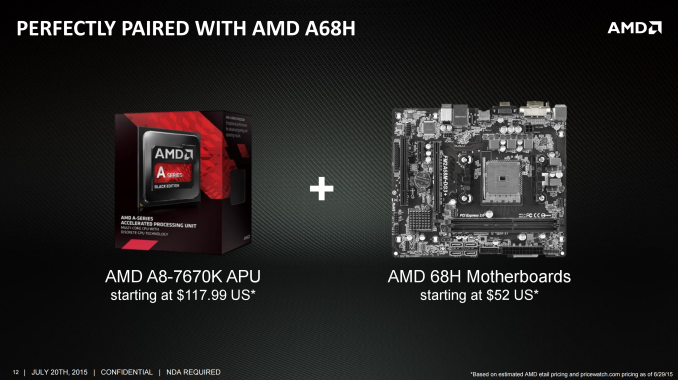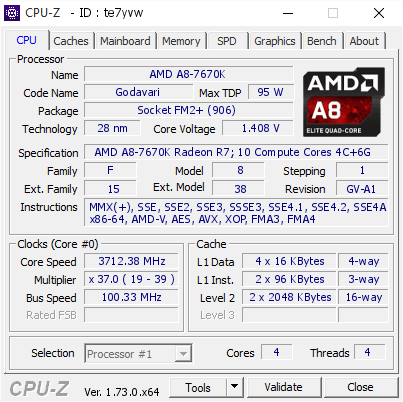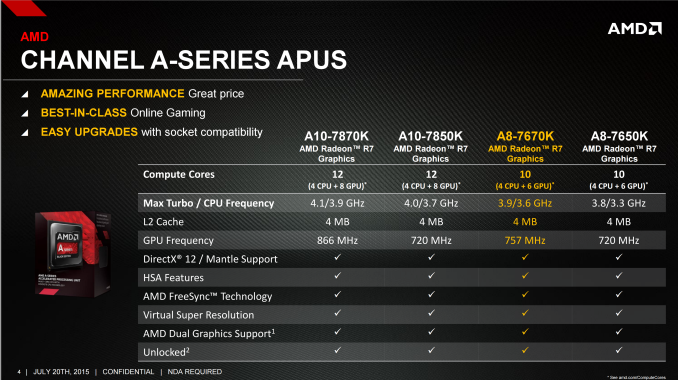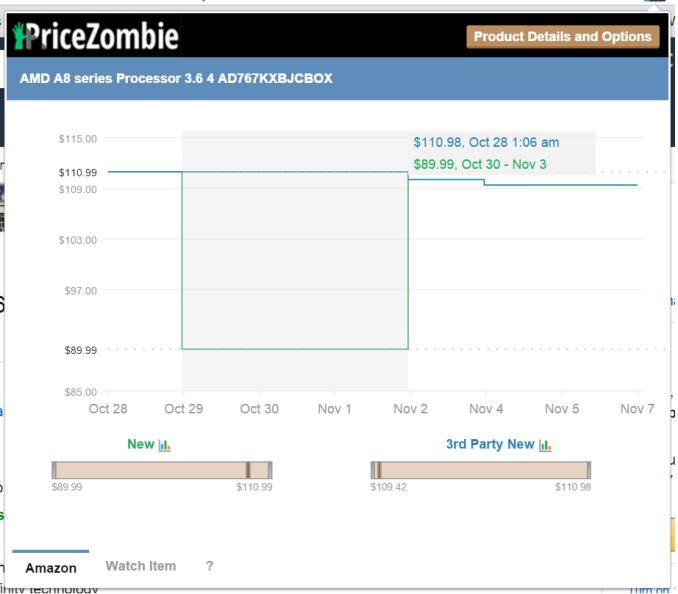The AMD A8-7670K APU Review: Aiming for Rocket League
by Ian Cutress on November 18, 2015 8:00 AM EST
Over the past couple of years, AMD has slowly released their mainstream brand of Kaveri processors. In turn, we have reviewed them, and they consistently aim to provide a midrange integrated gaming option, especially for those on a budget. The recent release of the A8-7670K was perhaps not that exciting, as AMD is filling up their product stack with new parts, taking advantage of an improved manufacturing process and aggressive binning. To that end, we're taking a different tack with this review. Alongside the regular tests, we also corralled Rocket League (an amazingly simple yet popular take on car football/soccer that sits on the precipice of e-sports glory) into a benchmark aimed at those sub-$600 gaming systems.
The AMD A8-7670K
Earlier this year, AMD announced their new line of Kaveri Refresh processors, starting with the A10-7870K (which we reviewed here). As the name suggests, these are Kaveri processors at their core, still based on the combination of Steamroller processor cores and 2nd generation Graphics Core Next (GCN) microarchitecture for graphics. These new refresh models are designed to take advantage of minor improvements in manufacturing, resulting in the ability to get higher clock speed for the same power consumption, even 18 months after the first Kaveri processors hit the scene. As a result, these Refresh processors — or, to use AMD's internal code name, "Godavari" — fill in the blank spots in the product stack and supersede the older parts, with the aim of squeezing in more frequency and performance for the same power consumption. It sounds deceptively simple — improve your process, refresh the part at the same price, and reap the benefits.
If we look at AMD's current lineup, we see that this new A8-7670K surpasses the older A10-7700K on the specification sheet, and comes in cheaper when brand-new.
| AMD Kaveri Lineup | ||||||||
| A10- 7870K |
A10- 7850K |
A10- 7800 |
A10- 7700K |
A8- 7670K |
A8- 7650K |
A8- 7600 |
X4 860K |
|
| Price | $137 | $134 | $131 | $120 | $118 | $104 | $89 | $85 |
| Modules | 2 | 2 | 2 | 2 | 2 | 2 | 2 | 2 |
| Threads | 4 | 4 | 4 | 4 | 4 | 4 | 4 | 4 |
| Core Freq. (GHz) | 3.9-4.1 | 3.7-4.0 | 3.5-3.9 | 3.4-3.8 | 3.6-3.9 | 3.3-3.8 | 3.1-3.8 | 3.7-4.0 |
| Compute Units | 4+8 | 4+8 | 4+8 | 4+6 | 4+6 | 4+6 | 4+6 | 4+0 |
| Streaming Processors |
512 | 512 | 512 | 384 | 384 | 384 | 384 | N/A |
| IGP Freq. (MHz) | 866 | 720 | 720 | 720 | 754 | 720 | 720 | N/A |
| TDP | 95W | 95W | 65W | 95W | 95W | 95W | 65W | 95W |
| DRAM Frequency |
2133 | 2133 | 2133 | 2133 | 2133 | 2133 | 2133 | 1866 |
| L2 Cache | 2x2MB | 2x2MB | 2x2MB | 2x2MB | 2x2MB | 2x2MB | 2x2MB | 2x2MB |
As it stands, the A8-7670K is a dual-module 3.6 GHz base frequency processor with a boost frequency up to 3.9 GHz. It comes with six graphics compute units, which translates to 384 streaming processors, similar to other A8 parts, but at a slightly higher IGP frequency of 754 MHz. The combined increase in processor and integrated graphics frequencies come at no extra cost in thermal design, with the A8-7670K at the same 95W TDP.
One of AMD's marketing strategies with these ~$100 processors is the price/performance angle. Aside from the integrated graphics, each of the AMD processors can pair with an R7 240 or R7 250 graphics card (DDR3 or GDDR5; AMD suggests an R7 250 GDDR5, as you might expect) in a hybrid dual graphics scenario, boosting performance. Thus, for the same price as an APU and an R7 250 graphics card, on average, AMD aims to offer a better gaming experience — especially for games that run at around 60 frames per second on medium settings — than a similarly priced Intel + NVIDIA platform. We've seen this marketing spiel corroborated in previous reviews, and would expect not to see anything different here. At launch, AMD put a $118 price on the A8-7670K, which, in recent sales, has been pushed down to under $100 at times.
The A8-7670K is an FM2+ socket processor, and thus requires either an A88X, A85X, A78 or A68 motherboard to go with it in order to take full advantage. As part of the launch, and given that this processor is a slightly boosted A8-7650K, AMD sees value in pairing it with something like a $50 A68H motherboard, making an APU+MB combination around $150 when on sale. However, as one might imagine, due to the age of the FM2/FM2+ socket, there are relatively few "new" motherboards on the market. The last one we reviewed was MSI's A88X-G45 Gaming, which brought over some of the components seen on its new Intel gaming motherboards, but other manufacturers have also put out M.2 capable AMD chipset-based motherboards as well.













154 Comments
View All Comments
tipoo - Wednesday, November 18, 2015 - link
The FPS by percentile graph is nice, is that new to AT?Ian Cutress - Wednesday, November 18, 2015 - link
Ryan does some percentile data in GPU reviews, and we did some stuff around the CFX/SLI sync issues. But we did the FPS by percentile graphs a bit in the Fable Legends testing. Some benchmarks provide the per-frame data by default, others do not (depends on how you're polling), and then there's some post-processing which takes longer than you think. It's a sort of graph that only 3/4 lines can be on it without going overboard.tipoo - Wednesday, November 18, 2015 - link
Cool. I like it.tipoo - Wednesday, November 18, 2015 - link
For GTA V, it looks like dual graphics on the same settings gives lower framerates than the 240 alone? Is that right? Other than that you see a pretty nice boost with it.jaydee - Wednesday, November 18, 2015 - link
I noticed that too and was wonderingyannigr2 - Wednesday, November 18, 2015 - link
APUs are excellent solutions for systems without graphics. If you are going to add a graphics card, then excluding dual graphics, APUs seem much less attractive. A8 7600 is in my opinion the best cheap APU you can get for a system without a discrete graphics card, 78X0K are an option ONLY when you are definitely never going to add a graphics card and you want the best possible integrated GPU, without having to rob a bank for an Iris GPU.But even when AMD's APUs are the best option, people will still rush to make people avoid them. That's AMD's doing and we can only blame them. Recently someone asked for a cheap system to play an old FPS game. Videos on youtube where showing that an A8 7600 could play the game. That didn't stopped people rushing in the thread to insist that, that game wasn't going to be fun with under 140 fps. Yes, 140 fps. They didn't considered gaming peripherals, or a gaming monitor important, only 140 fps. Anything to "save" someone from an AMD APU and send him to Intel. Even if this means convincing someone paying at least $80-$100 that he may not have. At the same time the same persons blame ONLY AMD for the lack of competition.
Dribble - Wednesday, November 18, 2015 - link
AMD's solutions appeal to pretty well no one. If you don't have an add in gpu chances are you don't want to game in which case Intel wins hands down. If you want to game you'll buy a cheap graphics card in which case Intel wins hands down.The mythical buying market that want to game on a desktop but can't even afford a basic add on card just doesn't exist. We know this because AMD have been trying to sell apu's like this one for years now and no one is buying.
Yorgos - Wednesday, November 18, 2015 - link
That's false,I am gaming in 1080p and I play many games above 25fps with almost high settings.
A good example is skyrim with the high definition mod that you can get from steam and I am constantly at 25 fps.
All this was tested on my 8750k and 2400 MHz ram. What's your point of reference?
OTOH, there is a shitload of ppl that play only MOBA games or FPS like cs where you don't need to spend 300 or more in a system. A 150$ system can get you constant 30 fps w/o a sweat.Plus you get a discrete grade GPU embedded with your cpu and you get all the goodies and the high quality drivers/support the discrete gpus get. Intel has none of the previous.
Dribble - Wednesday, November 18, 2015 - link
I would point you to AMDs CPU sales. No one is buying, AMD have been trying to sell cpu's like this one for years and failing - the market isn't there.medi03 - Thursday, November 19, 2015 - link
I would point you to the fact that Netburst outsold superior Athlon 64s 4 to 1.